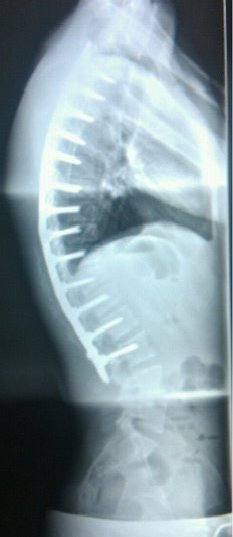Scheuermann's Disease
Scheuermann's disease, also known as Scheuermann's kyphosis, Calvé disease, or idiopathic juvenile kyphosis of the spine, is a self-limiting skeletal disorder predominantly affecting adolescents. Named after Danish surgeon Holger Scheuermann, it is characterised by an uneven growth of vertebrae, leading to kyphosis. This condition manifests as a prominent curvature of the upper back and is often accompanied by chronic pain.

Signs and Symptoms
Scheuermann's disease is a form of juvenile osteochondrosis of the spine, presenting more severely than postural kyphosis and often found in teenagers. Patients cannot consciously correct their posture due to the rigidity of the thoracic vertebrae curve. This condition is notorious for causing severe and disabling lower and mid-level back and neck pain, aggravated by physical activity or prolonged standing/sitting. The resulting deformity can cause sufferers to feel isolated or uneasy, especially in children.
Patients often experience loss of vertebral height and may present with a visual 'hunchback' or 'roundback.' Pain and cosmetic concerns are common reasons for seeking medical help. The seventh to tenth thoracic vertebrae are most commonly affected, potentially leading to internal problems and spinal cord damage in extreme cases, though such occurrences are rare.
Pain: Patients with Scheuermann’s disease are at a higher risk for back pain and disabilities during daily activities. However, the degree of thoracic kyphosis is not directly related to back pain, quality of life, or general health.
Associated Conditions
Many patients with Scheuermann's disease have an excessive lordotic curve in the lumbar spine to compensate for the kyphotic curve. They often have broad, barrel chests and large lung capacities as a natural compensation for reduced breathing depth. There is a noted association between Scheuermann's disease and lower than average bone density, increasing the risk for osteopenia and osteoporosis.
Causes
The exact cause of Scheuermann's disease is unknown, but it appears to be multifactorial. Genetic factors are suspected, given the exclusion of candidate genes like FBN1 associated with Marfan syndrome. An underlying neurological disorder may also contribute to the disease's development.
Diagnosis
Diagnosis typically involves medical imaging, such as X-rays or MRI. The degree of kyphosis can be measured using Cobb's angle and sagittal balance.

Treatment
Conservative
Scheuermann's disease is generally self-limiting after growth is complete, with the deformity typically maintained in adulthood. Early intervention aims to correct kyphosis while the spine is still growing. Treatment methods include physical therapy, manual medicine, back braces, and the Schroth method, a specialised physical therapy system shown to reduce pain and decrease the kyphotic angle.
Bracing is another conservative treatment to prevent progression and sometimes reduce the hyperkyphosis Cobb angle. The effectiveness of physiotherapy and bracing is well-documented in literature.
Surgery

Surgery is generally considered a last resort when conservative treatments fail or the patient's health is at risk. Surgical options include posterior-only fusion and anterior/posterior fusion, with trends favouring posterior-only fusion. The procedure involves inserting titanium rods and screws, cutting ligaments, and replacing damaged discs with bone grafts to correct the spine's curvature.
Patients can expect an extended recovery period, including hospitalisation, bracing, and physical therapy. The success rate of these surgeries is relatively high, but they carry risks such as inflammation, nerve injury, and infection. Reoperation may be required in some cases.
Self-assessment MCQs (single best answer)
What is another name for Scheuermann's disease?
Which age group is predominantly affected by Scheuermann's disease?
Which part of the spine is most commonly affected by Scheuermann's disease?
Which of the following is NOT a common symptom of Scheuermann's disease?
What diagnostic tool is typically used to diagnose Scheuermann's disease?
Which of the following is a conservative treatment for Scheuermann's disease?
What surgical procedure is often used to treat severe cases of Scheuermann's disease?
Which of the following is a risk associated with surgical treatment for Scheuermann's disease?
Which medical method is used to measure the degree of kyphosis in Scheuermann's disease?
Which of the following athletes is known to have Scheuermann's disease?
Dentaljuce
Dentaljuce provides Enhanced Continuing Professional Development (CPD) with GDC-approved Certificates for dental professionals worldwide.
Founded in 2009 by the award-winning Masters team from the School of Dentistry at the University of Birmingham, Dentaljuce has established itself as the leading platform for online CPD.
With over 100 high-quality online courses available for a single annual membership fee, Dentaljuce offers comprehensive e-learning designed for busy dental professionals.
The courses cover a complete range of topics, from clinical skills to patient communication, and are suitable for dentists, nurses, hygienists, therapists, students, and practice managers.
Dentaljuce features Dr. Aiden, a dentally trained AI-powered personal tutor available 24/7 to assist with queries and provide guidance through complex topics, enhancing the learning experience.
Check out our range of courses, or sign up now!


